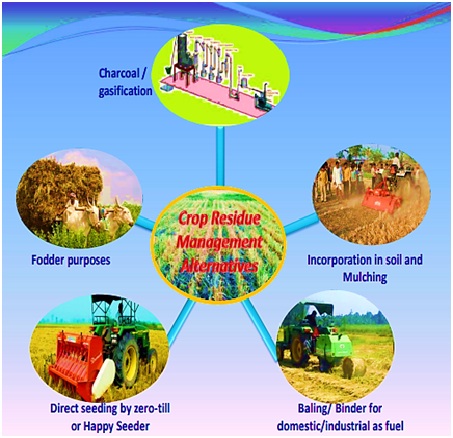Significant Decline In Stubble Burning: ICAR
- 13 Aug 2019
- According to the Indian Council of Agricultural Research (ICAR), there was 41 percent reduction in crop residue burning in Punjab, Haryana, Uttar Pradesh and Delhi-NCR,North India in 2018 compared with that in 2016.
Reduction in Incidents of Crop Residue Burning
- The incidents of crop residue burning have reduced by 40-45% in Haryana, 25% in western Uttar Pradesh and 14-15% in Punjab after farmers switched to happy seeder machine that helps them to earn more while also reducing air pollution.
- So far, 4,500 villages (covering 8 lakh hectare) in Punjab, Haryana and UP have been declared as ‘zero stubble burning’ during 2018 as not a single crop burning incident was reported from these villages during the year.
- This significant success was achieved due to the various efforts under the Central Sector Scheme on ‘Promotion of Agricultural Mechanization for In-Situ Management of Crop Residue in the State of Punjab, Haryana, Uttar Pradesh and NCT of Delhi’. Under which the farmers switched to happy seeder machine that helps them to earn more while also reducing air pollution.
Impact of Stubble Burning
Impact on Environment
- The burning of one tonne of paddy straw releases 3 kg particulate matter, 60 kg CO, 1460 kg CO2, 199 kg ash and 2 kg SO2, increasing the air pollution.
- In addition, a large number of toxic pollutants like methane, volatile organic compound and carcinogenic polycyclic aromatic hydrocarbons are released in the burning process giving rise to the formation of smog. Smog, further, increases the level of air pollution in nearby cities and completely wrecking the air quality index, hampering the atmospheric visibility, further impacting the reasons for climate change.
Impact on Soil Fertility
- Stubble burning destroys the existing minerals present in the soil which adversely hampers the cultivation of the next crop. The on field impact of burning includes removal of a large portion of the organic material, making it less fertile.
- The heat from burning paddy straw penetrates 1 centimetre into the soil, elevating the temperature to 33.8 to 42.2 degree Celsius. This kills the bacterial and fungal populations critical for a fertile soil, thus adversely affecting the soil ecology.
- Due to the loss of friendly pests, the impact of harmful pests increases and as a result, crops are more prone to disease. The solubility capacity of the upper layers of soil is also reduced drastically.
- In addition to these, other soil properties like soil temperature, pH, moisture, available phosphorus are greatly affected due to burning.
Impact on Human Health
- Burning crops release particulate matter(PM) 2.5 thatis easily carried away along the wind, causing numerous health issues.These particles are tiny enough to get trapped deep inside the lungs, increasing the risk of lung cancer by 36 percent.
- The smog-formation and poisonous gases arising from the stubble burning in Punjab and Haryana turns Delhi and other regions of the Gangetic plains into a gas chamber.
- Children (below 5 years) and elderly (above 59 years) in urban areas are at high risk of acute respiratory infection (ARI) associated with crop burning, compared to those living in rural areas.
Impact on Economy
- According to a report published by the International Food Policy Research Institute (IFPRI) in January, 2019, India loses $30 billion every year from crop fires.
- The estimated the economic cost of exposure to air pollution from crop residue burning at USD 35 billion or nearly Rs. 2.35 lakh crore annually for the three north Indian states of Punjab, Haryana and Delhi.
- Further, it warns that in next five years economic loss because of burning of crop residue would be $190 billion.
Government Initiatives towards Reducing Stubble BurningLaws that are in operation pertaining to crop residue burning:
National Policy for Management of Crop Residue (NPMCR) Objectives:
Promotion of Agricultural Mechanization for in-situ Management of Crop Residue:
Components of the Scheme:
|
Possible Alternatives to Stubble Burning
- Subsidizing the stubble collecting machines at rent
- Provision of reasonable labor to reap the paddy to refrain from stubble generation
- To let cattle graze or feed upon to clear away husk and stubble
- Decomposing stubble in the farm field and turning it into the useful manure
- Making fodder for livestock out of collected stubble
- Setting up Bio-mass fuel plants to generate fuel using paddy husk.

Additionally, farmers can also manage crop residues effectively by employing agricultural machines like:
- Happy Seeder(used for sowing of crop in standing stubble)
- Rotavator (used for land preparation and incorporation of crop stubble in the soil)
- Zero till seed drill (used for land preparations directly sowing of seeds in the previous crop stubble)
- Baler (used for collection of straw and making bales of the paddy stubble)
- Paddy Straw Chopper (cutting of paddy stubble for easily mixing with the soil)
- Reaper Binder (used for harvesting paddy stubble and making into bundles)
Way Forward
- Despite efforts from the Indian government, farmers continue to burn crop residues due to lack of convenient and affordable alternatives. Therefore, educating the farming community and other related stakeholders is crucially important to bring them out of generational thinking that they are used to that the waste management is not their responsibility. It is even more important to empower them with technical as well as socioeconomic assistance.
- The government needs to design effective policy interventions, agricultural cooperatives, farmer unions, even individual farmers have to work collectively to ensure successful implementation of policies, leading to development of the country, both economically as well as environmentally.


